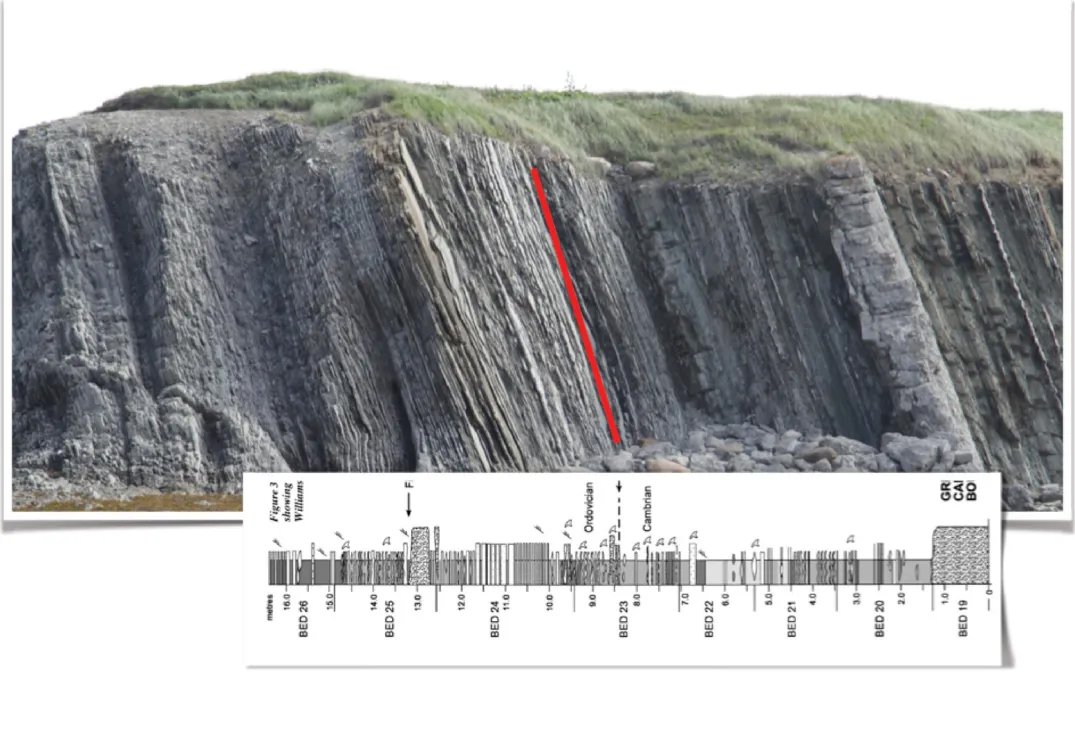Boundary|Time|Surface
Boundary|Time|Surface was a site-specific ephemeral sculptural installation that took as its basis the internationally recognized designation of the geological boundary between the Cambrian and Ordovician periods at Green Point, Newfoundland.
Just as individuals speak colloquially of “crossing the line” or “drawing a line in the sand” or even “invading our personal space” to mark various limits (and points of transgression), so too socio-political entities create borders, erect boundary markers, declare and define limits. Limits for time, limits for physical space, and limits which identify places, things, and people. But these limits are rarely – if ever – truly fixed or static: they are essentially arbitrary and subjective creations that fulfill specific needs at a given time, and are also convenient delimiters that reveal a particular view of the relationship between humans and the natural world. As such, these borders and limits - these definitions - are can be subject to forces beyond their creators’ control.
Boundary|Time|Surface thus presents an intervention within the landscape that simultaneously inscribes the human impulse to define and contain things much larger than ourselves, and the arbitrary (and problematic) nature of such actions.
Stratigraphic Column adapted from: R.A. Cooper, G.S. Nowlan, and S.H. Williams 2001 “Global Stratotype Section and Point for base of the Ordovician System. Episodes, Vol 24, no.1.
This work was created over a single four-hour period during the falling tide on June 22, 2014, on the shore at Green Point, in Gros Morne National Park, Newfoundland. The installation consisted of 52 found driftwood poles and roughly 300 rocks, all from Green Cove and Green Point, moved and positioned by hand in advance of installation day by me and my assistant, geologist John Waldron. The installation itself was built collaboratively by me, John, and 6 additional volunteers: Anne Marceau, Michael Burzynski, Renee Martin, Lisa Liu, Shawna White, and Ryan Lacombe. The work was 150 metres in length when completed, and the poles ranged in height between roughly 1.8 to 2.4 metres. Evidence of its existence remained at the site for approximately 48 hours: 34 poles has been felled by the tide by sunset on June 22 2014; 5 remained standing on the morning of June 23 2014; and one remained on the 24th.

























The creation of this installation was supported by an Art in the Park Residency. This is a joint program of Parks Canada and The Rooms, and supported by funding from the Canada Council for the Arts.
Boundary|Time|Surface was exhibited for the first time in 2016 at the Discovery Centre Gallery in Gros Morne National Park, just outside Woody Point NL. This multi-media, installation-based body of work exploring (and expanding upon) many of the concerns underlying the creation of the original installation.
Exhibition Information
This body of interrelated work considers different scales of time and types of memory; by extension, Boundary|Time|Surface is an extended visual meditation upon our relationship to the land and place, time, and the ‘how’ and ‘why’ of the ways we organize our lives.
The creation of this work for exhibition at the Discovery Centre was supported by funding from the Alberta Foundation for the Arts.
The second iteration of Boundary|Time|Surface was on exhibition at the Art Gallery of St. Albert, September 5 – November 2, 2019. This exhibition includes four new mixed-media wall-based works, a completely redesigned projection-mapped video installation with new footage, a large-scale presentation of a time-lapse video of the creation and destruction of the site-specific installation, in addition to a fabric installation work and a photo installation both of which were from the original exhibition.
The Arts & Heritage Foundation of St Albert published Boundary|Time|Surface – a record of change to coincide with this exhibition. This is a limited-edition artist book with catalogue section, featuring a critical essay by art historian and independent curator Melinda Pinfold, PhD; an essay on the history of geology as a science, by Dr. John Waldron, and an essay and poetry by me.
Support for this publication was also provided by the Alberta Foundation for the Arts, gratefully acknowledged.
John Waldron and I have presented several talks on this project; to date we have spoken at:
European Geoscience Union, Fundy Geological Museum, McGill University, Edmonton Geological Society, Atlantic Geoscience Society, Discovery Centre, Gros Morne National Park, Art Gallery of St. Albert, LASER Alberta Speakers Series, Acadia University, Atlantic Universities Geological Conference.
In addition, I have published a paper with John on the project which was published in Geoscience Communication in 2020.















